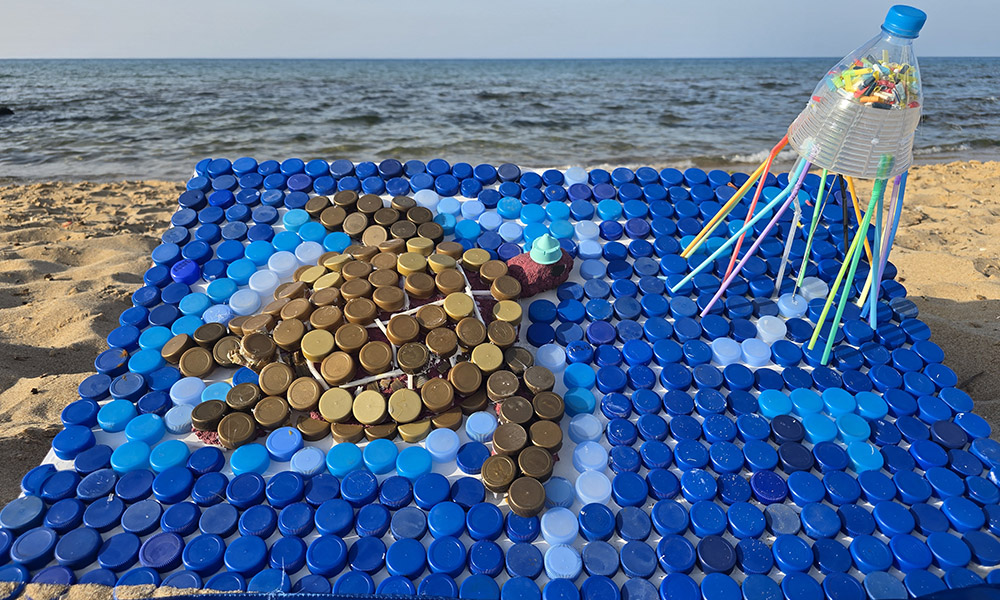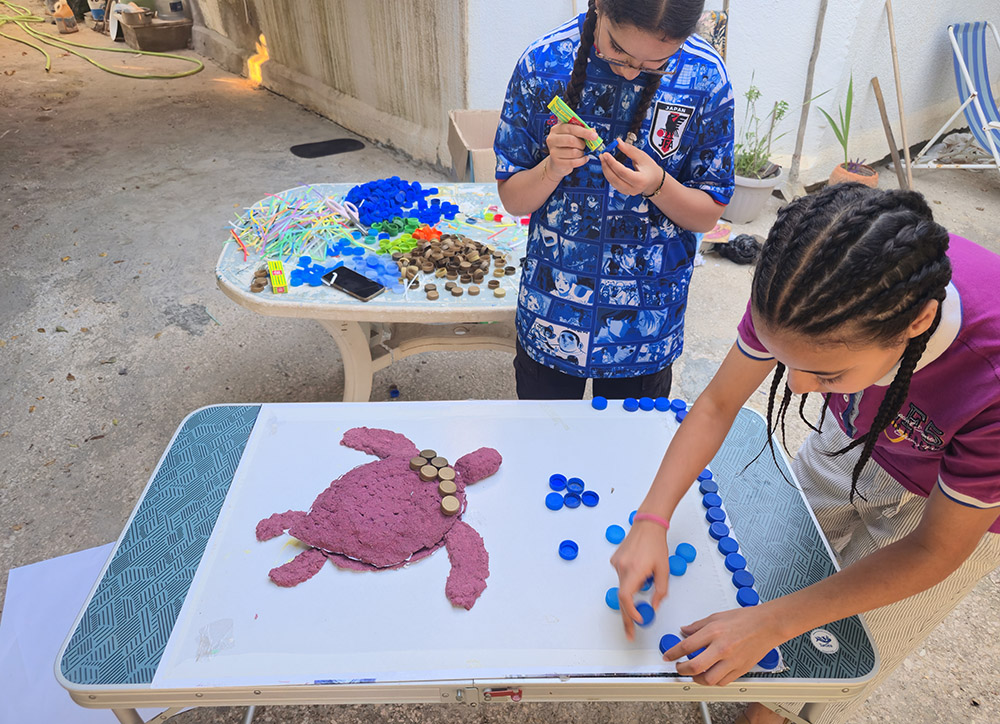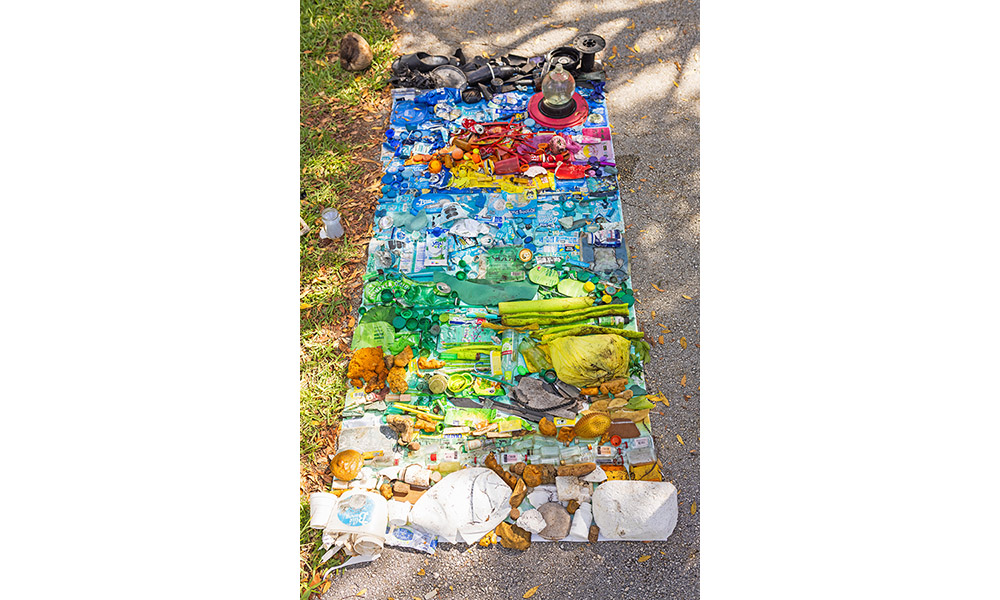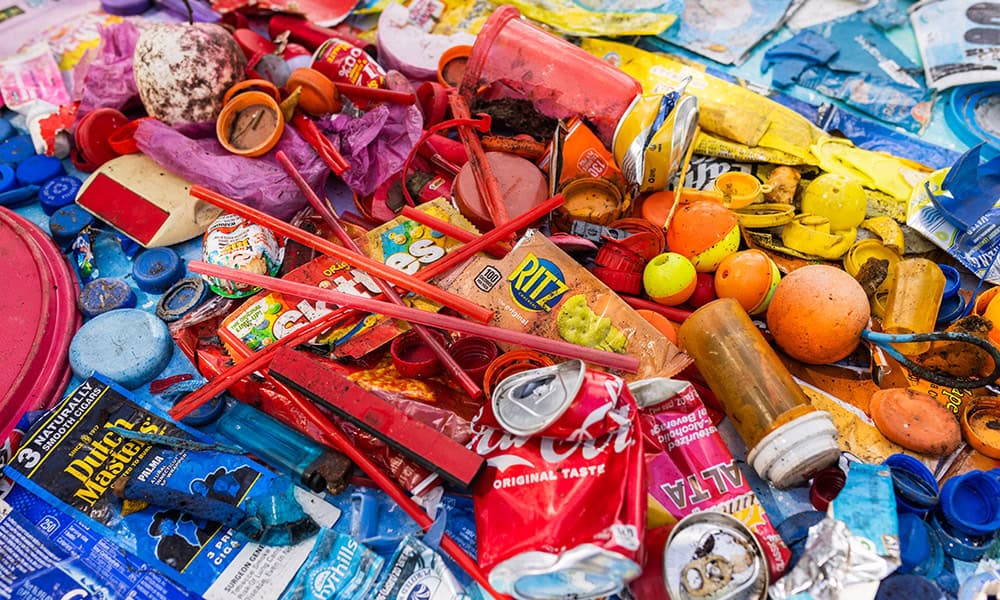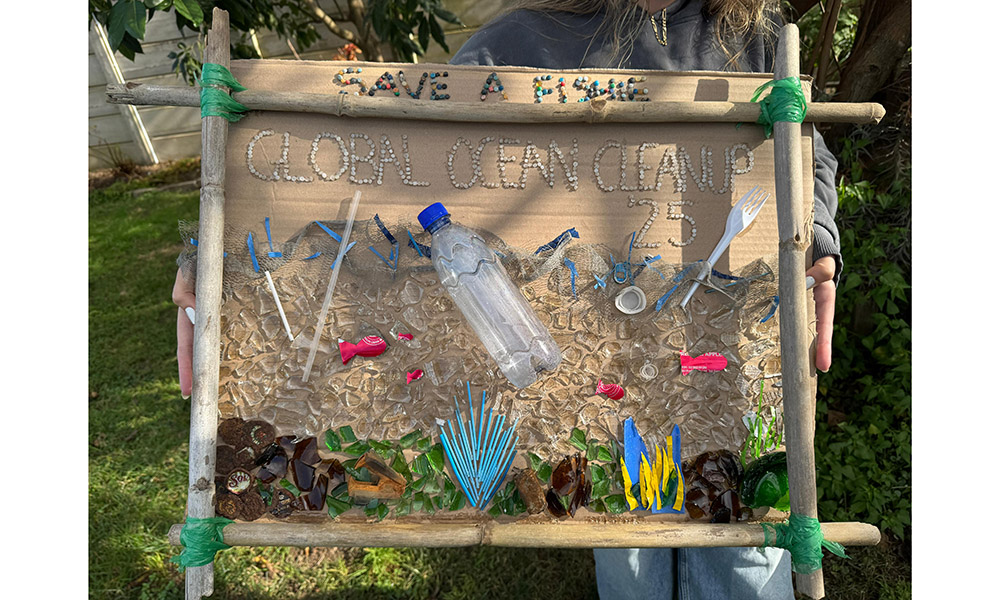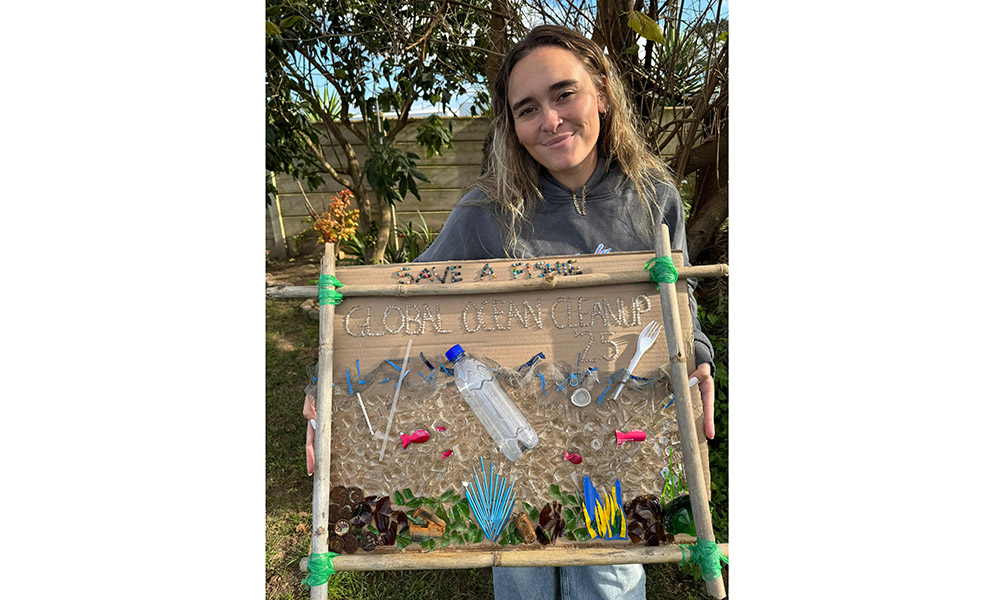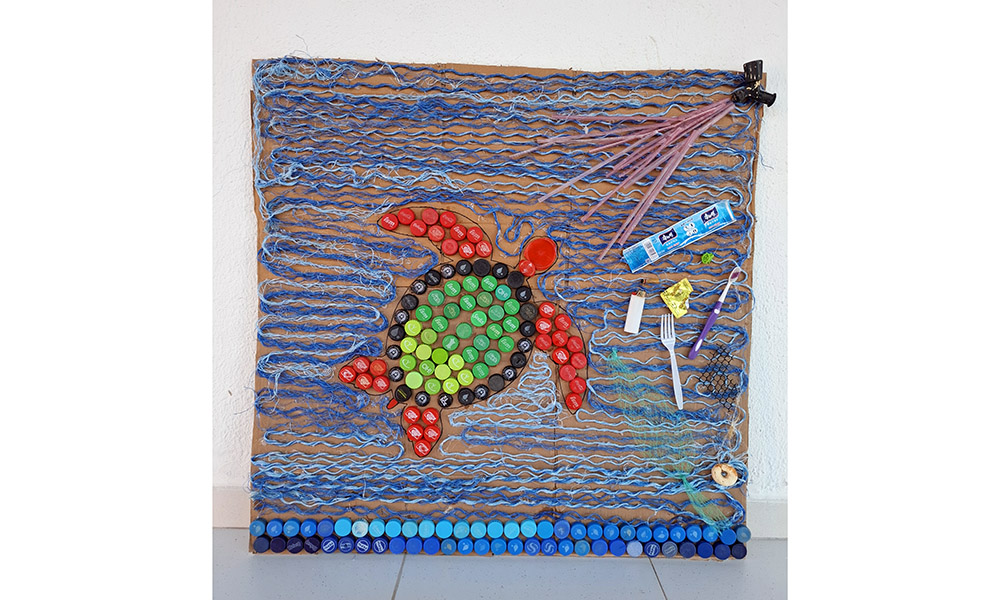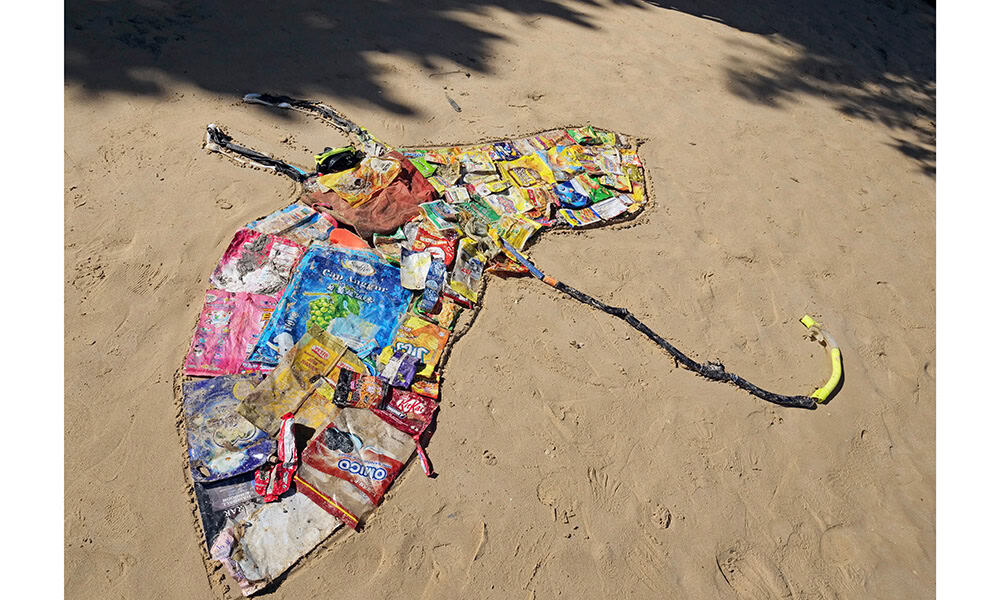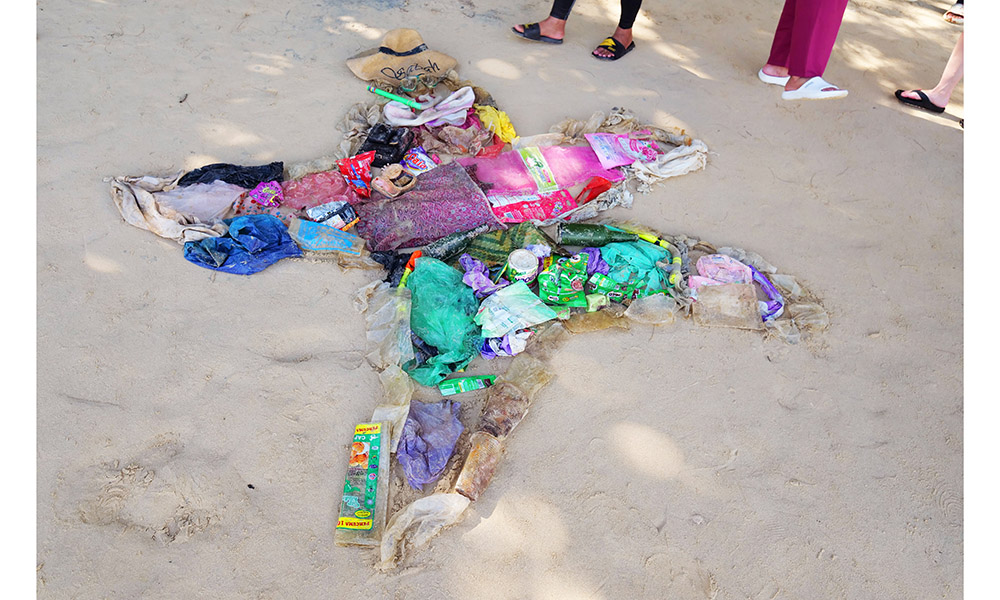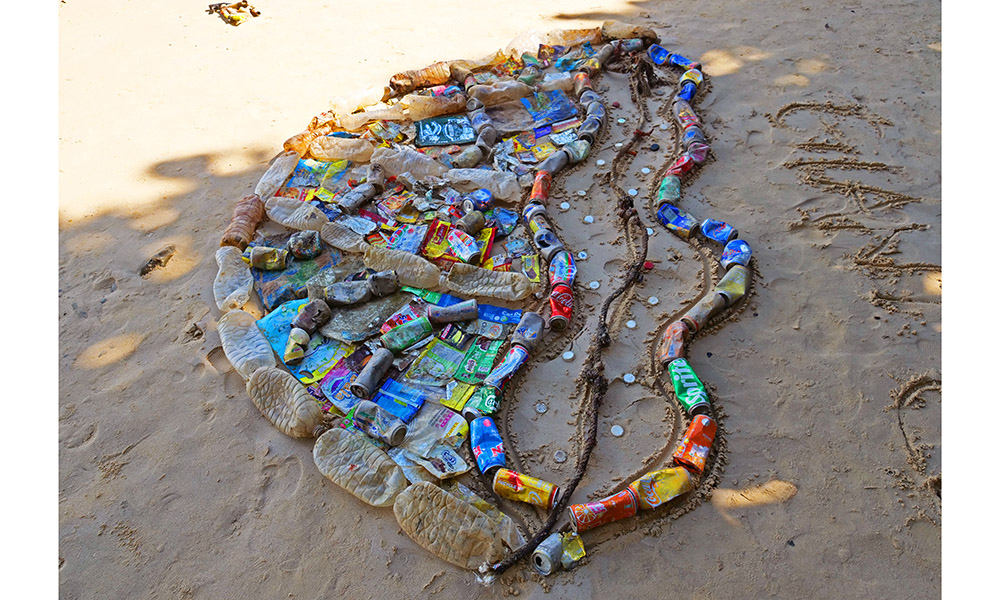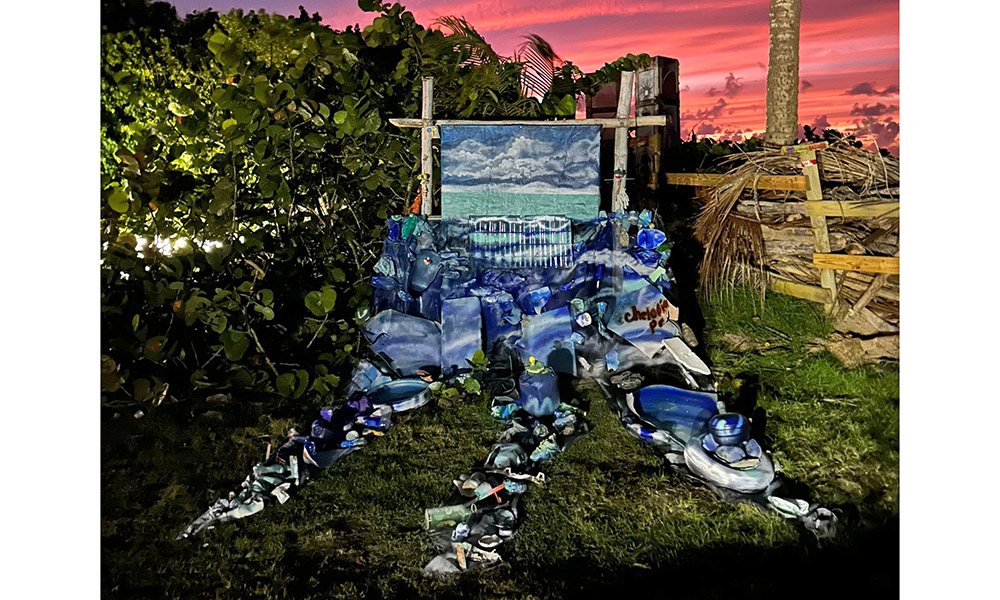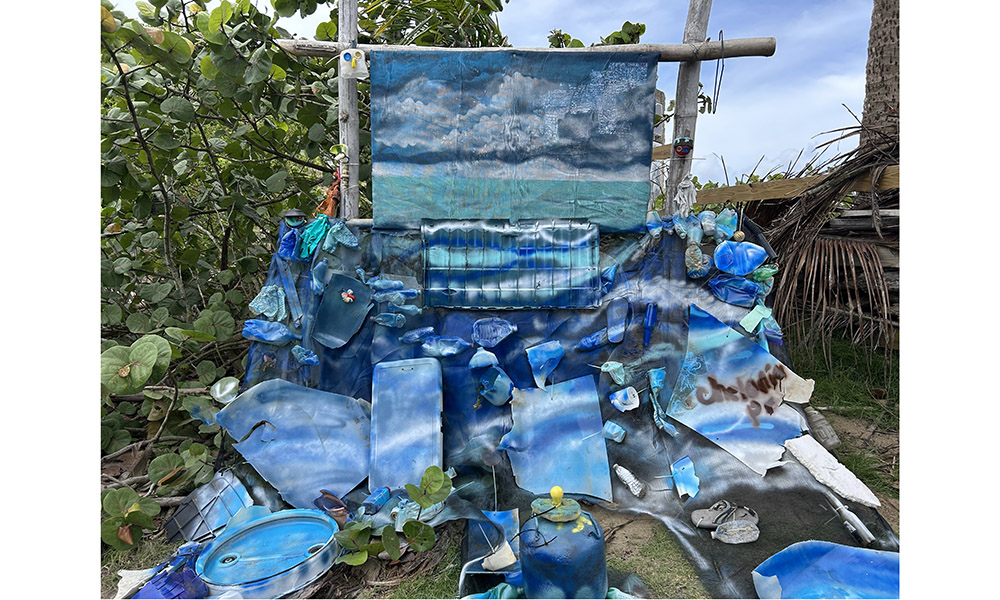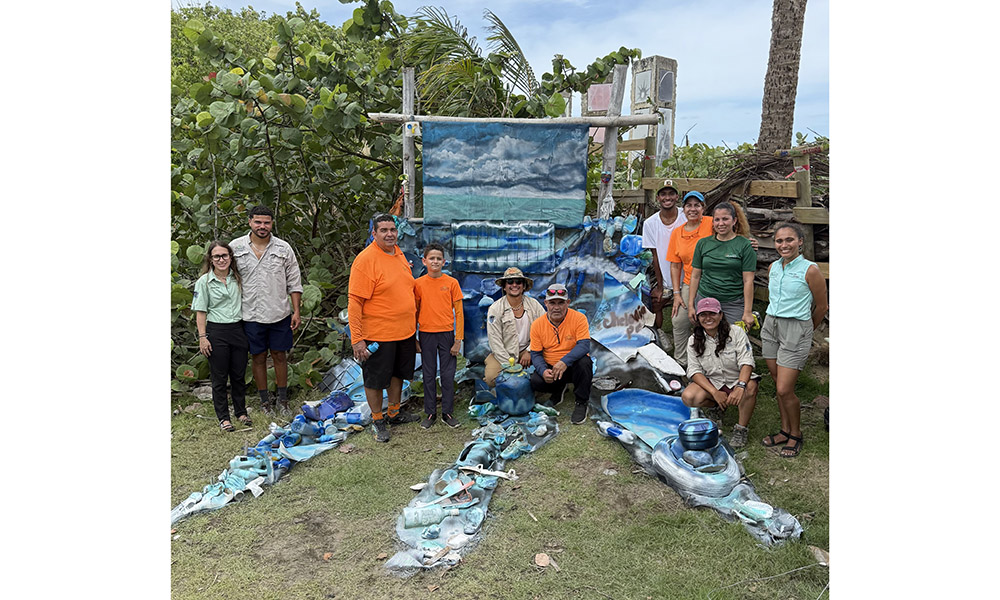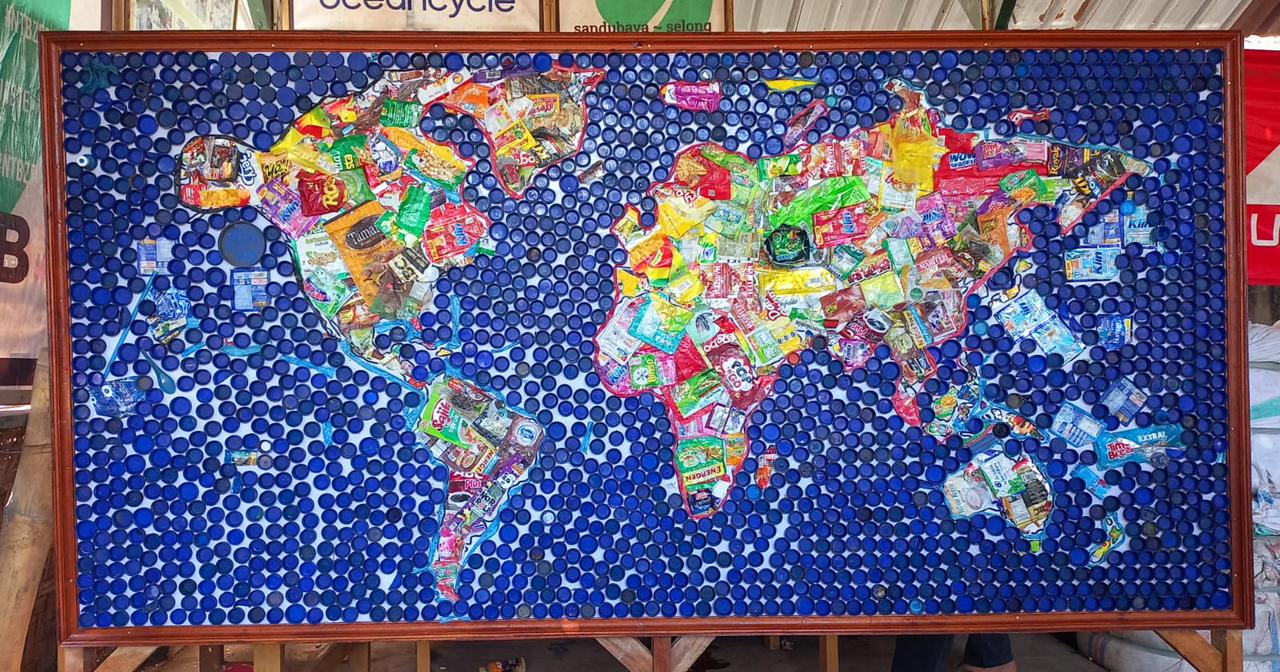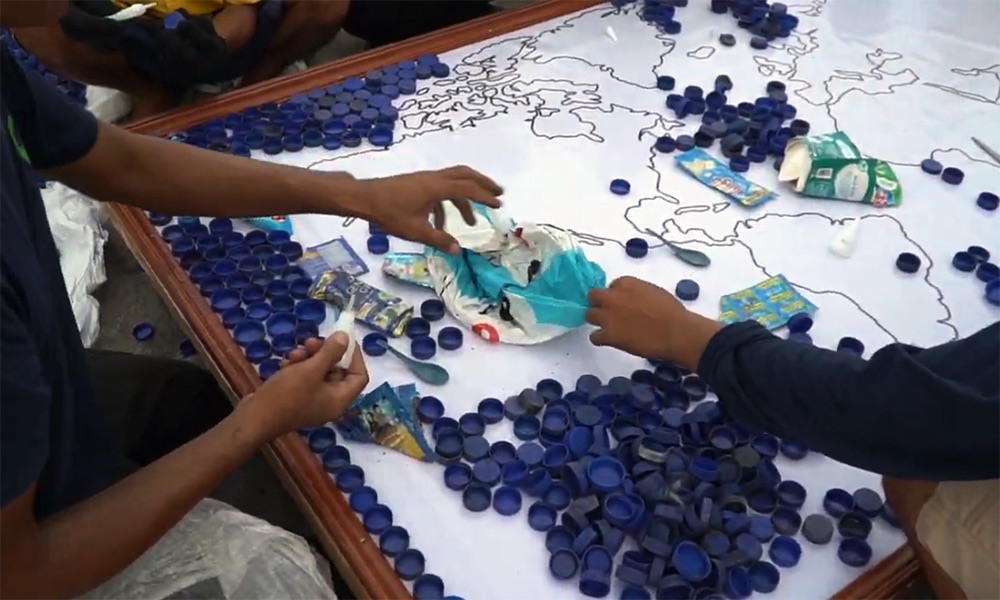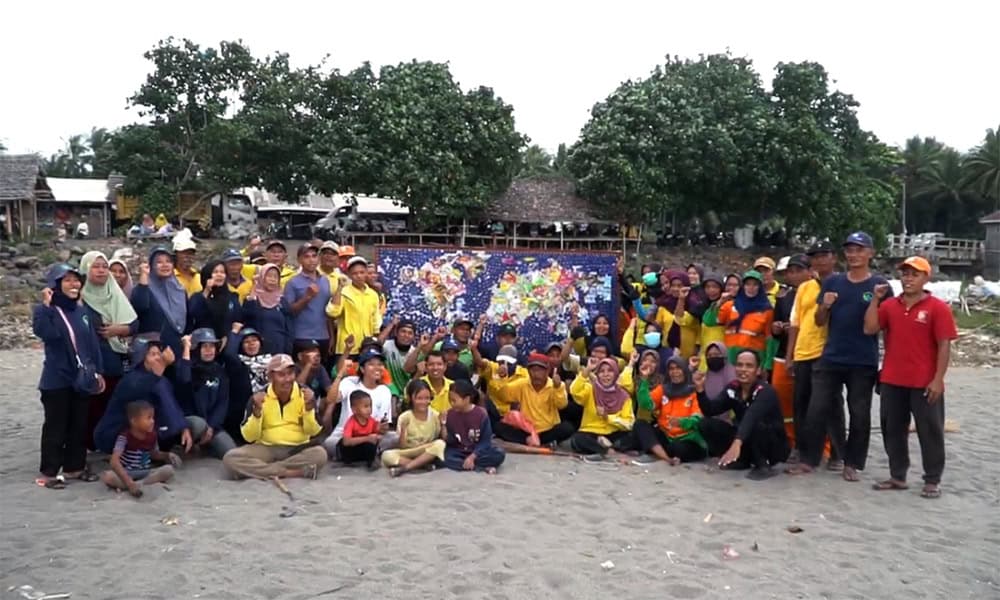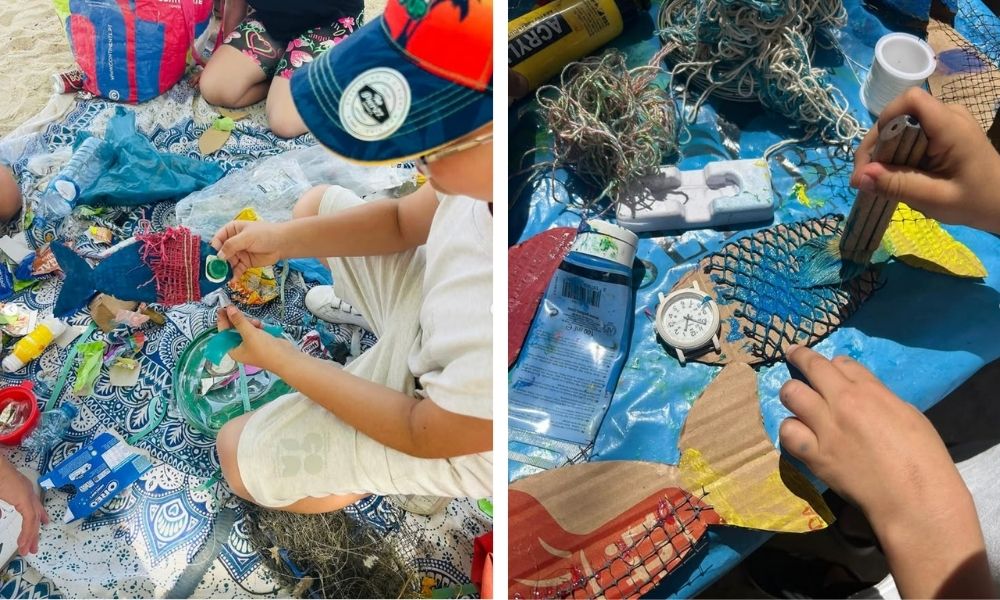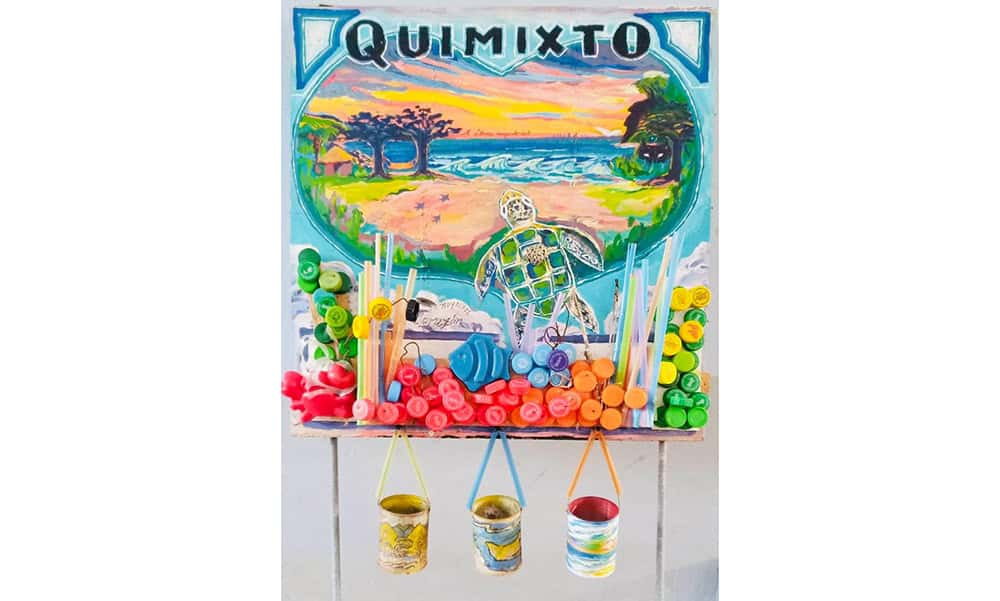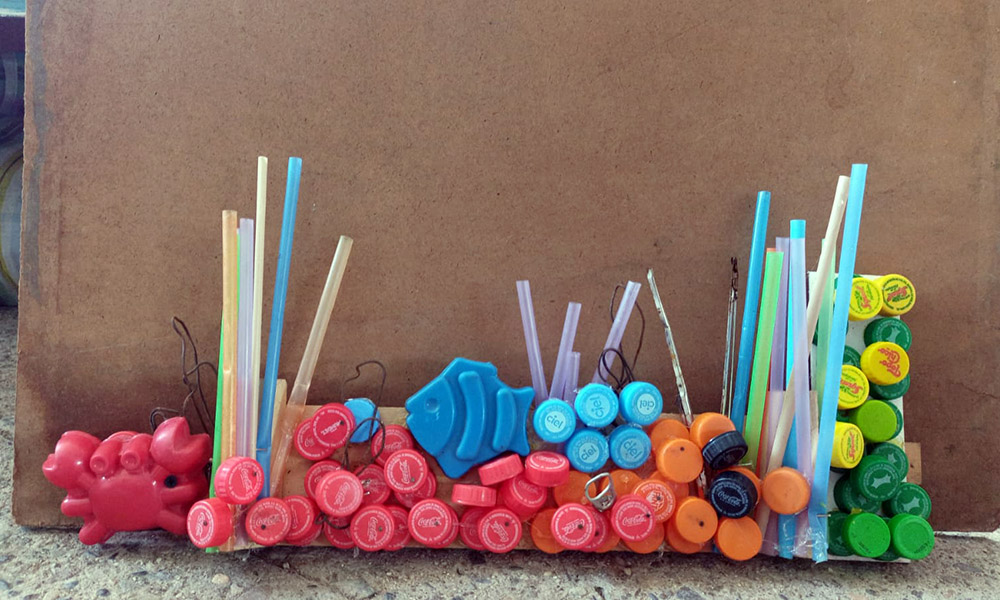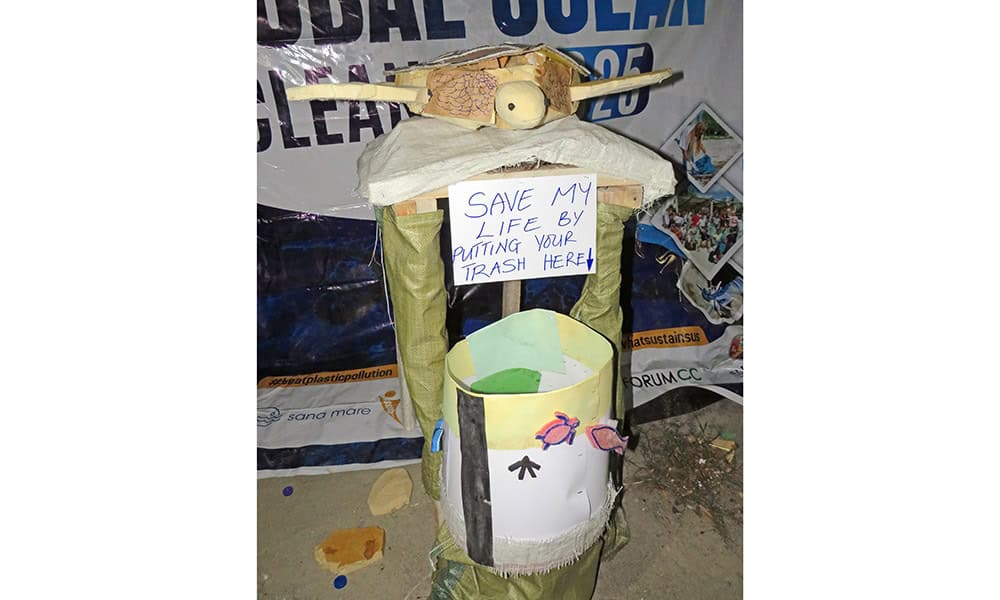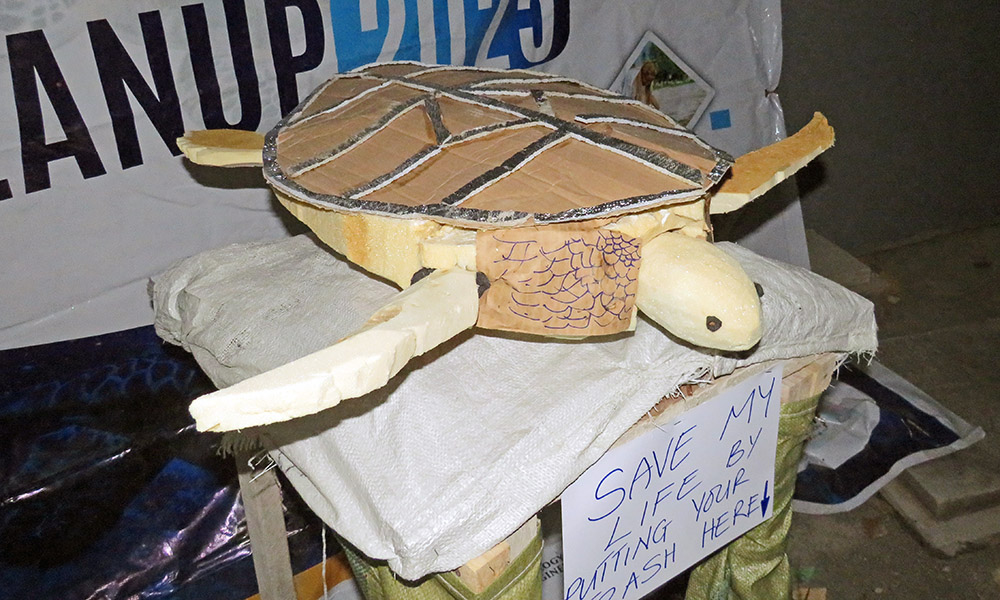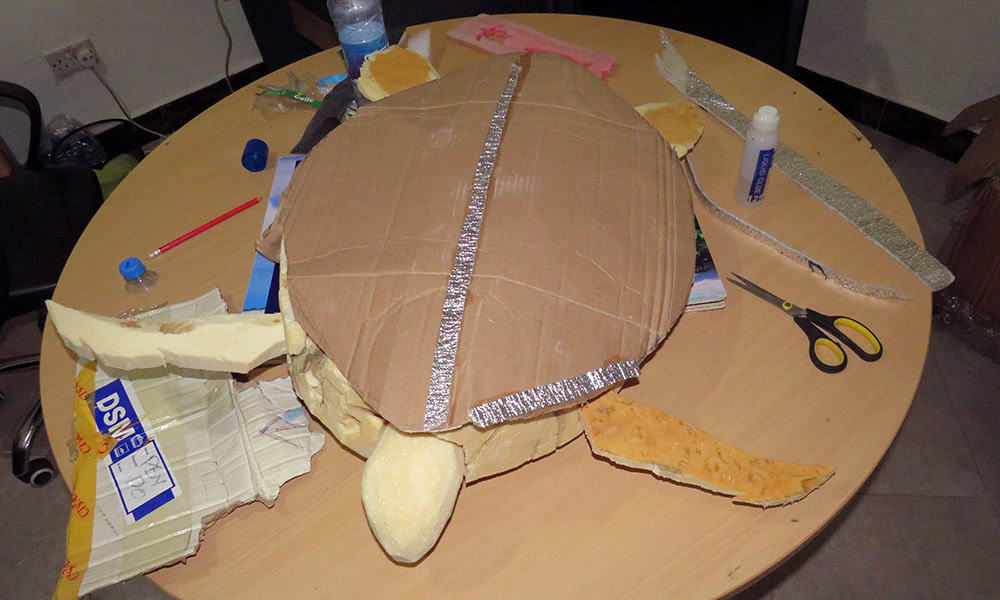Art Competition Entries & Voting
We are thrilled to share the official entries of the 2025 Global Ocean Cleanup Art Competition. Contest winners were selected through an online audience choice vote, and by our expert judges. See the final results below.
Entry 1: TunSea - Tunisia
Title: Turtle in Troubled Waters
Description: For this piece, the sea turtle's shape was crafted from an upcycled egg tray carton and covered with brown and gold bottle caps, symbolizing marine species endangered by plastic pollution. The ocean background of blue and white caps represents both the beauty of our seas and the growing threats they face. A jellyfish, constructed from a reused plastic bottle filled with microplastics and adorned with colorful straws, illustrates how marine creatures mistake trash for food.
Artist Statement: Co-created by Anas Ghzaiel, TunSea’s Project Manager, with young niece, Assil Enneifer: “This piece carries the message that change can begin at any age through creativity, care, and collective action. It's a call to protect the ocean before it's too late.”
Entry 2: Big Blue & You + Clean Miami Beach - Miami, USA
Title: Transitions and Transformations
Description: This vertical seascape invites viewers to stand at the beach's edge, looking over shallow waters where a southern stingray's shadow drifts beneath the surface. As the gaze moves toward the horizon, the setting sun bathes the scene in shifting colors, evoking natural transitions between day and night, surface and depth, stillness and movement. Constructed entirely from discarded materials collected during shoreline cleanup.
Artist Statement: Created by artist Kim Rizio: “The work reflects on cycles of transformation—both ecological and personal. Trash, once overlooked and devalued, is reshaped into something colorful and reflective. Through this piece, I hope to challenge how we define value and beauty, asking us to see potential where we once saw waste and consider our role in shaping transformation.”
Entry 3: Save a Fishie - South Africa
Title: Our Plastic Future in a Sea of Glass
Description: Created using 100% items collected from the beach—from backing cardboard to glass, ocean water, rocks and seaweed, to floating bottles, forks and straws, even down to sunken "treasure" including a rusted staple remover and battery. The focus on glass materials addresses the particular problem at our cleanup beach, where public drinking and bottle disposal have become a serious issue.
Artist Statement: Led by Save A Fishie’s Zoë Prinsloo: “Our decision to use mainly glass comes from the particular beach we cleaned at where public drinking and the throwing of bottles onto the beach has become a real problem. Having run over 400 cleanups, we've seen it all. While plastic pollution is well-known, we decided to highlight both plastic litter and the increasing issue of broken and discarded glass bottles. Glass poses environmental and health risks, with more beachgoers cutting their feet on broken glass. This piece brings attention to all forms of litter polluting our oceans.”
Entry 4: Instituto Biota - Brazil
Title: Untitled
Description: Created by volunteers using materials collected during beach cleanup—bottle caps, nylon ropes, straws, packaging, and other items commonly found affecting marine organisms. The base is made of reused cardboard. The turtle is constructed from bottle caps, symbolizing how plastic is already inside these animals. A faucet placed on the frame's edge represents humans who continue dumping waste into the ocean. Plastic straws flow from the faucet toward the turtle, highlighting constant threats.
Artist Statement: "Our artwork seeks to show that plastic pollution is real—and if we don't act, there will be nowhere to escape." Including unusual items like a condom wrapper, lighter, toothbrush, and bottle label with Asian characters shows that any improperly disposed item can end up anywhere in the ocean. This artwork aims to make people reflect on their actions and realize that every piece of trash has the potential to harm marine life.
Entry 5: Marine Research Foundation - Malaysia
Title: Anatomy of the Breathless Sea
Description: A trio of marine animal sculptures—manta ray, giant clam, and starfish—crafted entirely from marine debris retrieved from Tunku Abdul Rahman Park waters in Kota Kinabalu, Sabah. Volunteers divided into three teams, each selecting their favorite marine animal to sculpt using only collected trash. This creative challenge ignited imagination and fostered unity and purpose through teamwork.
Artist Statement: “Plastics are long-lasting and often go unnoticed as they blend into the ocean, entering the food chain and becoming part of marine life. These sculptures, made from plastic waste once polluting the sea, reveal how trash ends up inside marine animals. Our mission is removing plastic from the ocean while exploring sustainable waste management. Though simple in form, these sculptures deliver a powerful message and offer an accessible way to understand marine plastic pollution's impact.”
Entry 6: Chelonia - Puerto Rico
Title: Mareas de Basura (Trash Tides)
Description: Created entirely from beach-collected trash, including plastics, foam, tires, and discarded gas tanks from endangered leatherback turtle nesting grounds. The chaotic, colorful composition represents the overwhelming sea of debris these ancient travelers face each season, both as hatchlings and returning adults.
Artist Statement: “As volunteers and a collective, we created this piece from what the sea could no longer carry. This artwork is both memorial and message, reflecting the fragile journey of hatchlings who must crawl through debris before reaching water, and adult turtles navigating a world shaped by human waste. This is not just art—it's a call to recognize our role, restore balance, and protect what still has a chance to thrive.”
Entry 7: OceanCycle - Indonesia
Title: GeoPlastic: The Map We Made
Description: The OceanCycle team and volunteers created a world map made with plastic waste collected from shores, pieced together with bottle caps, lids, and fragments that each carry stories of consumption, neglect, and now reclamation.
Artist Statement: "This world map isn't drawn with ink or etched in stone. It's pieced together with what we've left behind. GeoPlastic reflects the world we're shaping through our habits, where borders are not only geographical but also environmental. This is the map we made. Now, it's up to us to reshape it."
Entry 8: Ocean Alive - Portugal
Title: Plastic School of Fish
Description: Created during a saltmarsh cleanup in the Sado estuary near a fishing pier in Faralhão. Local students participated in cleanup activities while reflecting on marine pollution and plastic waste impact. Each student wrote personal messages and created individual "trash fish" using collected debris, resulting in a collective "plastic school of fish."
Artist Statement: Through hands-on creation and reflection, students connected directly with the marine pollution issue, transforming collected waste into art while developing environmental awareness and personal commitment to ocean protection.
Entry 9: The Science Exchange - Mexico
Title: Quimixto
Description: Created by artist Karla De la Pena using a recycled wood board and metal stands from discarded furniture with acrylic background painting. Materials from Los Tules cleanup include bottle caps forming a reef scene where trash ends up if not properly disposed. The piece features portable ashtrays made from collected tin cans, chains, and straws. Manufacturer names on bottle caps (Coca-Cola, Ciel, Topo Chico) send a message to the entire chain from manufacturer to consumer.
Artist Statement: "To all children of heart and soul, whether you're 1 or 100 years old, everything can be a canvas when we have an important message to share. With trash collected from the beach, we create a reef. The message is: if we don't take care of what we choose to consume, we are suffocating or killing environments. We must change. Our minds are red—we must change them more to blue. More water. That's how we heal."
Entry 10: SOA Tanzania - Tanzania
Title: Save My Life
Description: A handmade sculpture made by SOA Tanzania’s team and volunteers features a sea turtle resting atop a recycling station, symbolizing marine life's silent suffering from human negligence. Constructed using upcycled materials, including a cardboard box, a fridge, and a buoy for the turtle's body, illuminated plastic paper for the shell, and rubber pieces for eyes. The custom-designed dustbin beneath is reinforced with a buoyant base and wrapped with sackcloth, decorated with cut-out slippers shaped as marine creatures.
Artist Statement: “This sculpture blends art, advocacy, and functionality as an interactive educational tool. The bold message, ‘SAVE MY LIFE BY PUTTING YOUR TRASH HERE’ serves as a powerful call to action, reminding viewers that proper waste disposal is a simple yet vital step in protecting our oceans. Created to inspire people, especially youth and community members, to reflect on daily habits and become active participants in fighting plastic pollution.”
Art Contest Results
Our 2025 Global Ocean Cleanup Art Competition results are as follows:
Judges' Selections
Our esteemed panel of judges selected the following winners:
- Winner ($500): Marine Research Foundation (Malaysia)
- Runner-Up ($500): Chelonia (Puerto Rico)
Audience Choice Results
The following winner was selected through a public vote held online from June 20–25, 2025:
- Audience Choice Winner ($500): TunSea (Tunisia)
Congratulations and thank you to all of the 2025 Global Ocean Cleanup Art Contest participants!

